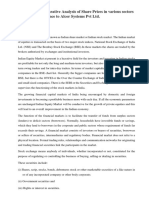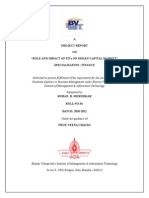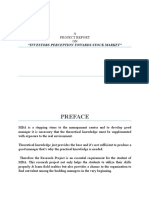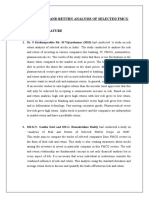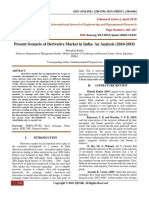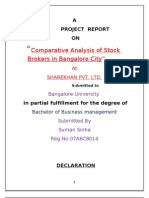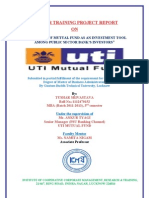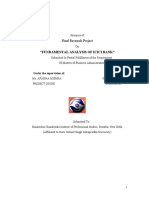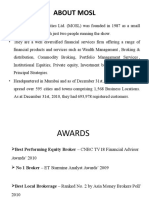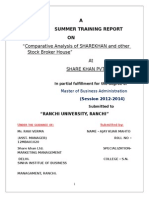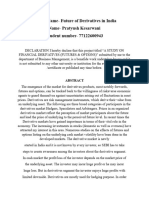A Study On Analysis of Equity Share Price Behavior of
A Study On Analysis of Equity Share Price Behavior of
Uploaded by
Sagar MundadaCopyright:
Available Formats
A Study On Analysis of Equity Share Price Behavior of
A Study On Analysis of Equity Share Price Behavior of
Uploaded by
Sagar MundadaOriginal Title
Copyright
Available Formats
Share this document
Did you find this document useful?
Is this content inappropriate?
Copyright:
Available Formats
A Study On Analysis of Equity Share Price Behavior of
A Study On Analysis of Equity Share Price Behavior of
Uploaded by
Sagar MundadaCopyright:
Available Formats
A Study on Analysis of Equity Share Price Behavior of the Selected Industries
ABSTRACT A STUDY ON ANALYSIS OF EQUITY SHARE PRICE BEHAVIOR OF THE SELECTED INDUSTRIES The Indian capital Market has witnessed a tremendous growth. There was an explosion of investor interest during the nineties and an Equity Guilt emerged in statutory legislations has helped the capital market. Foreign Exchange regulation act is one such legislation in this direction. An important recent development has been the Entry of Foreign Institutional investors are participants to the primary and secondary markets for the securities. In the past several years, investments in developing countries have increased remarkably. Among the developing countries India has received considerable capital inflows in recent years. The liberalization policy of the government of India has now started fielding results and the country is poised for a big leap in the industrial and economic growth. The Economy of the country is mainly based on the development of the corporate sectors. A better understanding of the stock market trend will facilitate allocation of financial sources to the most profitable investment opportunity. The behavior of stock returns will enable the investors to make appropriate investment decisions. The fluctuations of stock returns are due to several economic and non-economic factors. The study is aimed at ascertaining the behavior of share returns. This project analyses the equity share fluctuations in India Selected Industry. It also measures the strength of the trend and the money involved in investing in the stocks. Simple moving average model is applied for selected companies which would give the investor a sell signal or buy signal. In India most of the industries require huge amount of investments. Funds are raised mostly through the issue of share. An investor is satisfied from the reasonable return from investment in shares. Speculation involves higher risks to get return on the other hand investment involves no such risks and returns will be fair. An investor can succeed in his investment only when he is able to select the right shares. The investors should keenly watch the situations like market price, economy, company progress, returns, and the risk involved in a share before taking decision on a particular share. This study made will help the investors know the behaviour of share prices and thus can succeed. A STUDY ON ANALYSIS OF EQUITY SHARE PRICE BEHAVIOR OF THE SELECTED INDUSTRIES INTRODUCTION The Indian capital Market has witnessed a tremendous growth. There was an explosion of investor interest during the nineties and an Equity Guilt emerged in statutory legislations has helped the capital market. Foreign Exchange regulation act is one such legislation in this direction. An important recent development has been the Entry of Foreign Institutional investors are participants to the primary and secondary markets for the securities. In the past several years, investments in developing countries have increased remarkably. Among the developing countries India has received considerable capital inflows in recent years. The liberalization policy of the government of India has now started fielding results and the country is poised for a big leap in the industrial and economic growth. The Economy of the country is mainly based on the development of the corporate sectors. FACTORS AFFECTED FOR THE SHARE PRICES Share prices are affected by the following factors. The major factors are * Inflation * Deflation
* Interest Rates * Exchange Rates INFLATION An increase in the cost of goods and services over a period of time. Decreases the purchasing power of the dollar. It is usually measured by the consumer price index. INTEREST RATES The fee paid to a leader to borrow its money or a penalty charged for late payments usually shown as annual percentage rate. DEFLATION: The drop in the cost of goods and services over a period of time. Usually caused by a shrinking supply of money or credit, or reduced spending by consumers or government. Boosts Purchasing power of the dollar. EXCHANGE RATES: The price of one country's currency expressed in another country's currency. In other words, the rate at which one currency can be exchanged for another. REVIEW OF LITERATURE Bennet, James A.et.al (2001) have conducted a study on "can money flow predict is defined as the difference between up stick and down stick dollar trading volume. The study says that despite little published research regarding its usefulness, the measure has become an increasingly popular technical indicator because of its own means. The study summarizes its most important finding that money flow appears to predict across- sectional variation in future returns. Their predictive ability is sensitive, however, to the method of money flow measurement (eg. The exclusion or inclusion of block trades) and the Forecast horizon. Daigler Robert T.et.Al., (1981)2 have conducted a study on the development and testing of trading rules on the New York stock Exchange which are based on the discriminant Function. The study analysis the ability of daily technical indicators to predict future changes in the "standard and poor's 500 index". The study also signifies that the Technical indicators possess predictive ability to the extent that investor's possess predictive ability to the extent that investors believe they contain information on Future Market developments, and/or to the extent that the indicators reflect changing expectations among market participants. The study summarizes that the initial analysis of the relationship between daily technical data and future market movements is accomplished by examining the statistical difference between the group means (computed via the usual F test applied to the group means estimated from the discriminant function) of predicted "up days" versus predicted "down days" ("Up" and "down" days are define shortly). The statistical analysis is extended by classifying the observations into groups. Micko Tanaka Yamawaki et. Al., (2007) 7 have conducted a study on the Adaptive use of Technical Indicators for predicting the Intra-Day price movements. The researcher has proposed a system to select the best combination of technical indicators and their parameter values adaptively by learning the patterns from the tick-wise financial data. In this paper, the researcher has shown that this system gives good predictions on the directors of motion with the hitting rate at 10 ticks ahead of the decision point as
high as 70% for foreign exchange rates (FX) in five years from kl1996 to 2000 and 8 different stock prices in NYSE market in 1993 The study concludes that the tick-wise price time series carry a long memory of the order of at least a few minutes, which is equivalent to 10 ticks. OBJECTIVES OF THE STUDY * * * * * To To To To To analyze the share price behavior of the selected industries. predict the day to day Fluctuations in the stock market using Technical Analysis study the price movements in the stock exchange study the current trend and strength of the trend of selected industry recapitulate the key findings and offer suggestions to investors.
SCOPE OF THE STUDY A better understanding of the stock market trend will facilitate allocation of financial sources to the most profitable investment opportunity. The behavior of stock returns will enable the investors to make appropriate investment decisions. The fluctuations of stock returns are due to several economic and noneconomic factors. The study is aimed at ascertaining the behavior of share returns. The study on fluctuations in equity market helps in understanding the behavior of equity market. It helps the investors to be aware about deviations in the returns of the stocks. The simple moving average model indicates the buy and sell signal to the investors. This helps the investors is taking good decisions when investing in equity shares. The study also helps the customers to ascertain the risk and return of the stocks. This will help the investors viz, individuals, Files in identifying the stocks which would yield them higher return and lesser risk. RESERARCH METHODOLOGY Research Design This project analyses the equity share fluctuations in India Selected Industry. It also measures the strength of the trend and the money involved in investing in the stocks. Simple moving average model is applied for selected companies which would give the investor a sell signal or buy signal. Data and Sources of Data Secondary data was used for the analysis print media and internet has been used for data collection. The data also obtained by the national stock exchange website (www.nscindia.com). For the purpose of this study the daily closing prices of 15 companies included in National stock exchange were taken and their price movement are computed and studied. The sectors selected are as follows: * * * * * Automobile Banking IT Oil Exploration and Refinery Tele communication
* Automobile * Tata Motors Ltd. * Maruti Suzuki India Ltd.
* Bank * State Bank of India * ICICI Bank Ltd. * Oil Exploration and Refineries * Oil & Natural Gas Corporation Ltd. * Reliance Petroleum Ltd. * IT * Infosys Technology Ltd. * TATA Consultancy Services Ltd. * Telecom * Bharati Airtel Ltd * Reliance Communications Ltd. The purpose of this analysis is to false the 8 months solid data from the National Stock Exchange website and to predict the market trends in each of the above mentioned companies. TIME PERIOD COVERED The daily share prices of above mentioned companies were taken for a period of nearly one year from 1stJul 2009 to 30 the March 2010. The closing prices of share prices were taken and the future price movements were analyzed. METHOD OF SAMPLING Since for the purpose of this analysis five sectors are taken and from the five sectors two companies are taken in each sector. Therefore the sampling used for selection of the sectors is judgmental sampling based on the contribution of each sector to the GOP of the country. The three sample companies in each sector are selected based upon the Market capitalization of the companies in those sectors. In this method, items for the sample are selected on certain pre-determined criteria. The fixation of criteria and the choice of sampling may bring in personal element and introduce basis. This method is usually applied in small enquiries and researchers by individuals when they are familiar with all the items of the population. It is difficult to estimate the sampling error and the reliability of the result depends on the investigator and the impartiality in the choice of the item. TOOLS USED FOR ANALYSIS SIMPLE MOVING AVERAGE In technical analysis the moving average is one of key trend lines that are plot on a chart reflecting the closing prices over weeks. They smooth a data series and make it easier to spot trends, something that is especially helpful in volatile markets. They also form the building blocks for many other technical indicators and overlays. When the moving average moves above or below the daily chart, it may generate a buy or sell signal. A moving average is an indicator that shows the average value a security's price over a period of time. When calculating a moving average, a mathematical analysis of the security's average value over a predetermined time period is made. As the security's price changes, its average price moves up or down. We
can interpret a moving average by comparing the relationship between the moving averages of the security's price with the security's price itself. Buy signal: When the security's price rises above its moving average Sell Signal: When the security's price falls below its moving average. MONEY FLOW INDEX MFI is a more rigid indicator in its volume weighted, and is therefore a good measure of the strength of money flowing in and out of a security. It compares "Positive money flow" to create an indicator that can be compared to price in order to identify the strength or weakness of a trend. The MFI is measured on a 0 100 scale and is often calculated using a 14 day period.The MFI compares the ratio of "positive" money flow and "negative" money flow, if typical price today is greater than yesterday, then it is considered positive money. For a 14 day average. The sum of all positive money from those 14 days is the positive money flow. The MFI is based on the ratio of positive/negative money flow (money ratio) Typical Price = ((Day High +Day Low + Day close)/3) Money Flow = (Typical price) x (volume) Money Ratio = (Positive Money Flow/Negative Money Flow) Money Flow Index = 100 (100) (100/ 1+Money Ratio) RELATIVE STRENGTH INDEX The Relative strength Index (RSI) is and extremely useful and popular momentum oscillator. The RSI compares the magnitude of a stock's recent gains to the magnitude of its recent losses and returns that information into a number that ranges from 0 to 100. It takes a single parameter, the number of time periods to use in the calculation. Average gain = Total of gains during the past 14 periods/114 Average Loss = Total of Losses during the past 14 periods /114 RS = Average Gain/Average Loss RSI = 100- (100/(1 + RS)) FINDINGS AND INFERENCES Price fluctuation is a statistical measure of the tendency of market or security to rise or fall sharply within a short period of time. Generally higher the fluctuation of a security greater is it price swings larger fluctuations means returns fluctuate in a wide range. Also all securities does not behave in the same manner. It is the expertise of the researcher and investor as of to identify which indicator proves the best. AUTOMOBILE SECTOR TATA MOTORS LTD.
The daily closing price of TATA motors ltd. is found to be lesser than the moving average which indicates the stock is proceeding in a down trend and the bearish trend would continue until there is a buy or sell signal. The MFI value lies below the centre line which confirms the trend but index is moving upwards against the trend which indicates a certain market change in the trend in the near future. The RSI indicator lies well below the 30 marks which shows the stock is obviously oversold and there would a
definite bullish trend.
To conclude this is a better time for the stock to be bought as soon as the indicator shows a buy signal. MARUTI UDYOG LTD.
The daily closing price of maruti udyog ltd. is found to be lesser than that of the moving average which indicates that the stock is in a down trend and bearish signal would continue until there is a definite buy signal. The MFI value lies below the centre line which confirms the trend but index is moving upwards against the trend which indicates a certain change in the trend in the near future the RSI indicator has started to slow the over sold condition and this confirms there would be a trend reversal.
To conclude it is better to wait for the indicators to show some definite signal before making any buying decisions with the stock. BANKING SECTOR: STATE BANK OF INDIA
The daily closing price of state bank of India is found to be lesser than that of the moving average which indicates that the stock is in a downtrend and bearish signal would continue The MFI indicates a opposite signal as it trends in a direction opposite to that of the stocks direction and thus there would definitely be
a trend reversal. The RSI indicates the security is in oversold condition and would not take much longer to reverse its trend.
To conclude the indicators show that there would be a definite buy signal in the immediate future and hence investing in this stock would be a better option. ICICI BANK LTD.
The daily closing pirce of ICICI bank ltd. is found to lie below the moving average which indicates that the stock is in a down trend and bearish signal would continue. The MFI indicator shows the money the money flows is creeping very low and bearish trend is confirmed since it is well below the centre line. The RSI has just started to pleenge in to the over sold region and it is seen that the trend would continue.
To conclude with the stock has not shown any definite signal hence it is advisable to hold the stock and not make any further buy decisions unless the trend reversal signal appears.
--> Article continued on next page, click here -->
Source: E-mail December 1, 2011
You might also like
- Clothes - Traditional Clothing Around The WorldDocument3 pagesClothes - Traditional Clothing Around The WorldEnikő HorváthNo ratings yet
- Rais12 SM CH03Document46 pagesRais12 SM CH03Bima Adetya90% (10)
- Margaret Atwood S The Handmaid S Tale Critical Insight PDFDocument21 pagesMargaret Atwood S The Handmaid S Tale Critical Insight PDFEva Crusat100% (2)
- A Project Report SynopsisDocument6 pagesA Project Report SynopsisTrisha SohalNo ratings yet
- A Study of The Optimal Portfolio Construction Using Sharpe's Single Index ModelDocument100 pagesA Study of The Optimal Portfolio Construction Using Sharpe's Single Index ModelPrakash Reddy100% (1)
- (Perspectives in Sexuality) Joseph LoPiccolo (Auth.), Joseph LoPiccolo, Leslie LoPiccolo (Eds.) - Handbook of Sex Therapy (1978, Springer US)Document532 pages(Perspectives in Sexuality) Joseph LoPiccolo (Auth.), Joseph LoPiccolo, Leslie LoPiccolo (Eds.) - Handbook of Sex Therapy (1978, Springer US)Emoty100% (1)
- A Study On Analysis of Equity Share Price Behavior of The Selected IndustriesDocument9 pagesA Study On Analysis of Equity Share Price Behavior of The Selected IndustriesNoorunnishaNo ratings yet
- Volatility in Indian Stock MarketDocument6 pagesVolatility in Indian Stock MarketUpender GoelNo ratings yet
- Volatality in Stock MarketDocument16 pagesVolatality in Stock Marketpratik tanna0% (1)
- A Study On Equity Analysis at India-InfolineDocument21 pagesA Study On Equity Analysis at India-Infolinearjunmba119624No ratings yet
- Comparative Analysis of Share Price in Various SectorsDocument7 pagesComparative Analysis of Share Price in Various SectorsMallikarjun RaoNo ratings yet
- "Fundamental Analysis of Script Under Pharmaceutical Sector"Document82 pages"Fundamental Analysis of Script Under Pharmaceutical Sector"sg31No ratings yet
- Role and Impact of FIIs On Indian Capital MarketsDocument78 pagesRole and Impact of FIIs On Indian Capital MarketsSubham SahuNo ratings yet
- Investors Perception Towards Stock MarketDocument64 pagesInvestors Perception Towards Stock MarketsonuNo ratings yet
- SIP Project Fundamental AnalysisDocument63 pagesSIP Project Fundamental AnalysissunnyNo ratings yet
- Awareness About The Derivative and Its Comparison With EquityDocument102 pagesAwareness About The Derivative and Its Comparison With EquityJaiHanumankiNo ratings yet
- Working Capital Management India InfolineDocument83 pagesWorking Capital Management India Infolinearjunmba119624100% (1)
- Motilal Oswal ProjectDocument58 pagesMotilal Oswal Projectshrikantk_karnewarNo ratings yet
- PORTFOLIO MANAGEMENT SERVICES - AN INVESTMENT OPTION Sharekhan 2Document73 pagesPORTFOLIO MANAGEMENT SERVICES - AN INVESTMENT OPTION Sharekhan 2niceprachi0% (1)
- Fundamental Analysis of FMCG SectorDocument78 pagesFundamental Analysis of FMCG Sectormd_akhter_8No ratings yet
- Initial Public OfferingDocument97 pagesInitial Public OfferingMunna MunnaNo ratings yet
- IL & FS Investsmart: "Analysis of Mutual Fund & Customer Preference Towards Mutual Fund"Document56 pagesIL & FS Investsmart: "Analysis of Mutual Fund & Customer Preference Towards Mutual Fund"Vijetha EdduNo ratings yet
- Modified FDI & FII in India - A Comparative AnalysisDocument90 pagesModified FDI & FII in India - A Comparative AnalysisKewal JaganiNo ratings yet
- Nfo ProjectDocument75 pagesNfo Projectankitverma9716No ratings yet
- RELIGARE Securities Ltd-Vivek Singh ProjectDocument67 pagesRELIGARE Securities Ltd-Vivek Singh ProjectVivek SinghNo ratings yet
- A Study On Risk and Return Analysis of Selected FMCGDocument13 pagesA Study On Risk and Return Analysis of Selected FMCGKavya posanNo ratings yet
- Present Scenario of Derivative Market in India An AnalysisDocument7 pagesPresent Scenario of Derivative Market in India An AnalysisGaurav KumarNo ratings yet
- Bibliography Books: Research Methods For Graduate Business and Social Science StudentsDocument9 pagesBibliography Books: Research Methods For Graduate Business and Social Science StudentsyezdiarwNo ratings yet
- Sahrekhan Report DanishDocument68 pagesSahrekhan Report Danishdeepak9991No ratings yet
- Indian Automobile Industry PDFDocument28 pagesIndian Automobile Industry PDFAbel JohnNo ratings yet
- Derivatives Market in India 12345Document107 pagesDerivatives Market in India 12345Dastha GiriNo ratings yet
- Research Report On: "Comparative Analysis of Equity & Derivative Market"Document107 pagesResearch Report On: "Comparative Analysis of Equity & Derivative Market"Neetyesh TiwariNo ratings yet
- Sandeep Blackbook PlagiarismDocument50 pagesSandeep Blackbook PlagiarismRitvik SaxenaNo ratings yet
- A Study On Fundamental Analysis of Automobile Sector at Edelweiss Broking LTD, Bangalore PDFDocument86 pagesA Study On Fundamental Analysis of Automobile Sector at Edelweiss Broking LTD, Bangalore PDFkavithaNo ratings yet
- Impact of Fii On Stock MarketDocument66 pagesImpact of Fii On Stock MarketAmit ViraniNo ratings yet
- Mcom Project WordDocument53 pagesMcom Project WordAthul GNo ratings yet
- A Study of An Derivative Market in IndiaDocument22 pagesA Study of An Derivative Market in IndiaSuvankar MallickNo ratings yet
- Comparative Analysis of Stock BrokersDocument80 pagesComparative Analysis of Stock Brokerskanhu14350% (2)
- Risk and Return Analysis of Mutual FundsDocument3 pagesRisk and Return Analysis of Mutual FundsRoshni MishraNo ratings yet
- Uti Mutual FundDocument87 pagesUti Mutual FundTushar Srivastava100% (1)
- Sudhir Final Doc (1) (Autosaved) NEWDocument45 pagesSudhir Final Doc (1) (Autosaved) NEWArvindsingh1857gmailNo ratings yet
- India Bulls ProjectDocument108 pagesIndia Bulls ProjectSk Khasim50% (2)
- 123 Review of LiteratureDocument31 pages123 Review of LiteratureHari PriyaNo ratings yet
- 11 - Chapter 03 Review of LiteratureDocument66 pages11 - Chapter 03 Review of LiteratureAman GuptaNo ratings yet
- Fundamental Analysis On "FMCG Sector"Document30 pagesFundamental Analysis On "FMCG Sector"Ranju ChauhanNo ratings yet
- Motilal Oswal Mutual FundDocument15 pagesMotilal Oswal Mutual FundPraveen KumarNo ratings yet
- Fundamental Analysis of Public and Private Banks in IndiaDocument91 pagesFundamental Analysis of Public and Private Banks in IndiaNISHANT0% (1)
- Perception of Investors Towards Derivative Market With Special Reference To Indore District 837935667Document10 pagesPerception of Investors Towards Derivative Market With Special Reference To Indore District 837935667RAhuljain793_rjNo ratings yet
- Comparative Analysis of SHAREKHAN and Other Stock Broker HouseDocument78 pagesComparative Analysis of SHAREKHAN and Other Stock Broker Housedishank jain0% (1)
- Correlation of Indian Stock Market With AmericanDocument87 pagesCorrelation of Indian Stock Market With AmericanShubham PatilNo ratings yet
- Equity Market ProjectDocument54 pagesEquity Market ProjectDrKanchan GhodkeNo ratings yet
- Study of Derivatives: (Infosys LTD)Document66 pagesStudy of Derivatives: (Infosys LTD)yash daraNo ratings yet
- A Comparative Study of Ventura Securities LTD Equity Segment With Other Stock Broking Firms in LucunowDocument119 pagesA Comparative Study of Ventura Securities LTD Equity Segment With Other Stock Broking Firms in Lucunow9125103046No ratings yet
- Share Khan Summer ProjectDocument113 pagesShare Khan Summer Projectakash01190% (20)
- A Study On Equity Share Price Behavior of Selected Stocks From Different SectorsDocument9 pagesA Study On Equity Share Price Behavior of Selected Stocks From Different SectorsDeepak SinghalNo ratings yet
- Pim Project 2008Document104 pagesPim Project 2008pra_nthNo ratings yet
- A Study On Equity Share Price Behavior o PDFDocument8 pagesA Study On Equity Share Price Behavior o PDFSrishti SoniNo ratings yet
- A Study of Stock Index and Factors Affecting Share PricesDocument73 pagesA Study of Stock Index and Factors Affecting Share PricesPraveen KambleNo ratings yet
- Pavan Project On Equity Derivatives 2222222222222222222222222222Document55 pagesPavan Project On Equity Derivatives 2222222222222222222222222222ravan vlogsNo ratings yet
- A Study On Financial Derivatives (Futures & Options)Document93 pagesA Study On Financial Derivatives (Futures & Options)Vinod Ambolkar100% (2)
- ProjectDocument9 pagesProjectPratyush KesarwaniNo ratings yet
- MBA Project On Fundamental and Technical Analysis of Kotak BankDocument109 pagesMBA Project On Fundamental and Technical Analysis of Kotak BankSneha MaskaraNo ratings yet
- Ijrpr2741 Study On Investor Perception Towards Stock Market InvestmentDocument19 pagesIjrpr2741 Study On Investor Perception Towards Stock Market InvestmentAbhay RanaNo ratings yet
- Medicines Policy 81 PDFDocument48 pagesMedicines Policy 81 PDFPaulo'RodriguesNo ratings yet
- Bob Internet BankingDocument12 pagesBob Internet BankingSweta PandeyNo ratings yet
- DM - Module - 3 - PPT - Disasters and Development SEP 2021Document102 pagesDM - Module - 3 - PPT - Disasters and Development SEP 2021121810302054 A NEERAJNo ratings yet
- PNC Menon +91 99012 34604: Architects Name 1 2 3 4 5 6 7 8 9 10 11 12 13 14Document17 pagesPNC Menon +91 99012 34604: Architects Name 1 2 3 4 5 6 7 8 9 10 11 12 13 14prashantsinghhattNo ratings yet
- Dark BibleDocument134 pagesDark BibleRaza67% (3)
- How To Get Closer To GodDocument3 pagesHow To Get Closer To Godfonzycarlos359505No ratings yet
- Revelation (Christopher Lee Album)Document2 pagesRevelation (Christopher Lee Album)Remi DrigoNo ratings yet
- Nidan Volume 24 December 2012Document144 pagesNidan Volume 24 December 2012Nirmala1987No ratings yet
- Is 6128 1971Document17 pagesIs 6128 1971Indranath SinhaNo ratings yet
- Referral AgreementDocument3 pagesReferral AgreementBenj OrtizNo ratings yet
- NOD Issue1 May2010Document89 pagesNOD Issue1 May2010John Stater100% (2)
- Bank Concurrent Audit Report FormatDocument105 pagesBank Concurrent Audit Report FormatAdesh Nahar100% (2)
- MySQL CheatsheetDocument4 pagesMySQL CheatsheetGiova RossiNo ratings yet
- CorelDraw PDF FileDocument3 pagesCorelDraw PDF FileJoseph DavidNo ratings yet
- Writing Gender Writing Nation Women S Fiction in Post-Independence IndiaDocument4 pagesWriting Gender Writing Nation Women S Fiction in Post-Independence IndiaANKIT KUMAR DUBEYNo ratings yet
- Rental Agreement SWGDocument3 pagesRental Agreement SWGAlicia CheahNo ratings yet
- Thoughts of DR A (1) .P.J. Abdul KalamDocument12 pagesThoughts of DR A (1) .P.J. Abdul Kalamvenkatdhokale100% (6)
- Homework Pros and Cons ArticleDocument7 pagesHomework Pros and Cons Articlecjxksnapd100% (1)
- (GEEK Up) Backend - Technical Assessment - Summer 2024Document8 pages(GEEK Up) Backend - Technical Assessment - Summer 2024Tiến LêNo ratings yet
- Typical Mistakes-C (M.Swan 'Practical English Usage') 2018Document1 pageTypical Mistakes-C (M.Swan 'Practical English Usage') 2018Евгения МартыноваNo ratings yet
- Accounting FraudDocument22 pagesAccounting Fraudnabila dhiyaNo ratings yet
- 4.2 Risk Treatment ProcessDocument4 pages4.2 Risk Treatment ProcessRizky Hardiana de Toulouse-LautrecNo ratings yet
- Drinking Culture of The Philippines - WikipediaDocument3 pagesDrinking Culture of The Philippines - WikipediaABI Alco QANo ratings yet
- Lahore School of EconomicsDocument1 pageLahore School of EconomicsJohn MarryNo ratings yet
- English Notes 2.4 - ClaimDocument2 pagesEnglish Notes 2.4 - ClaimaxxNo ratings yet
- Literary Piece in England: "Beowulf" by Laurence NowellDocument11 pagesLiterary Piece in England: "Beowulf" by Laurence NowellJoanne Manglal-lan100% (1)










